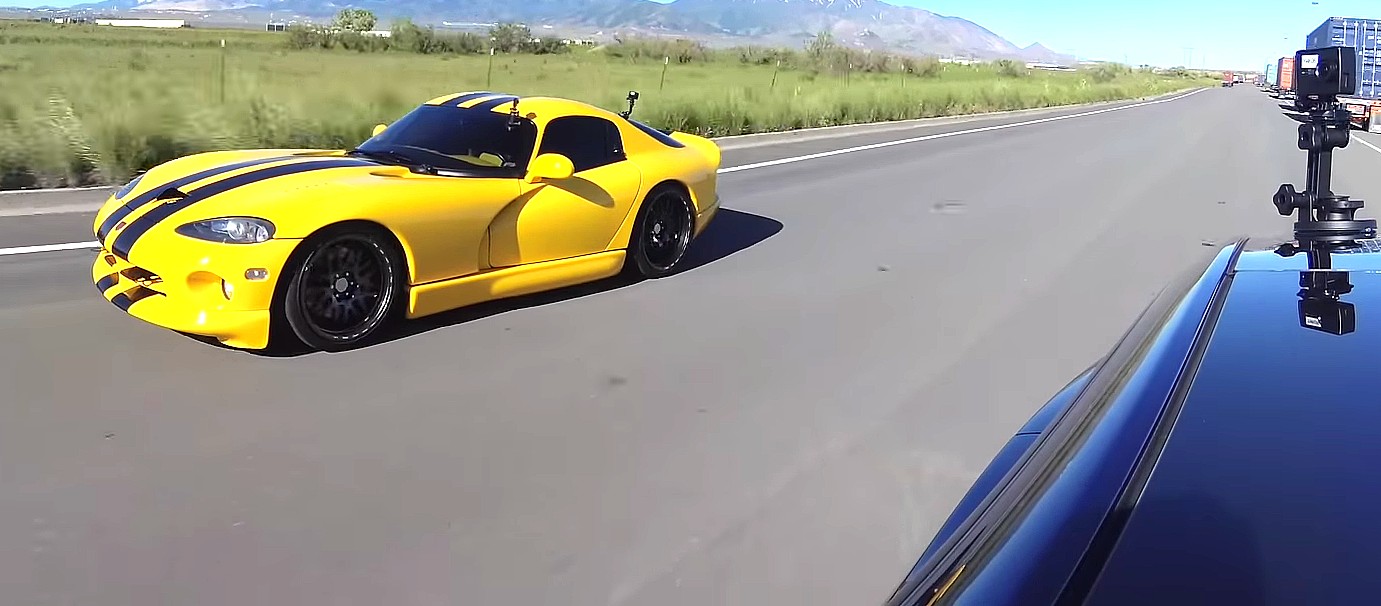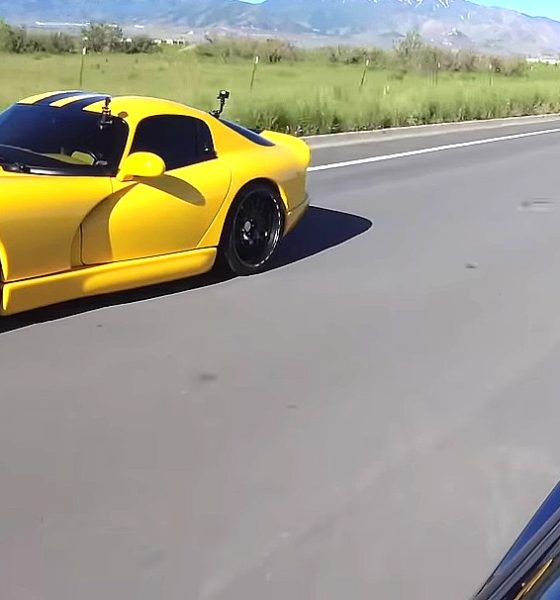

Lifestyle
Tesla Model 3 performance duels Dodge Viper GTS in multiple rolling races
A Tesla Model 3 Performance recently challenged one of America’s most iconic muscle cars, a 2001 Dodge Viper GTS with a fully-built engine. The Dodge Viper holds an esteemed and notorious place among muscle cars, mainly due to its reputation as a racecar for the streets.
Tesla Model 3 owner and car enthusiast DamienG Videos! of YouTube previously tested his 1997 Viper against his all-electric sedan from Silicon Valley. In his previous test, which could be accessed here, the Model 3 proved dominant, walking all over his Viper during multiple rolling races. So impressed was the auto enthusiast (and so strong was the reaction from the Viper community) that he issued an invitation to other Vipers that may be interested in racing his electric car.
It did not take long before a Viper owner took up the offer. This time around, the vehicle was a yellow 2001 Dodge Viper GTS with a fully-built motor. The muscle car has not been tested on a dyno, but the owner of the car noted that the vehicle had at least 500+ whp. This makes the muscle car very impressive, considering that a stock version of the 2001 Dodge Viper GTS features a bold 450 horsepower V-10 engine, which allowed it to hit 60 mph in just 4 seconds flat.
The vehicle’s racecar DNA is also evident in its credentials, as shown by the car’s race-modified siblings: three consecutive European FIA GT-2 championships, two consecutive class championships at the 24 Hours of Le Mans, the inaugural American Le Mans championship, as well as a historic overall championship at the 2000 24 Hours of Daytona. The vehicle, which performed very well both on and off track, was well-received by the US auto community, though it also got a reputation for being a dangerous car to drive.
In a way, the Dodge Viper could be considered the very antithesis of the Tesla Model 3 Performance. While the Viper is loud, the Model 3 is stealthy. While the Dodge has a penchant for being a deadly machine in the hands of inexperienced drivers, the Tesla proudly stands as one of the safest vehicles on the road. While these two vehicles do have their differences, the Viper and Model 3 Performance also have similarities. After all, they are both insanely fast cars.
The Model 3 Performance is equipped with dual motors that produce a combined 450 hp and 471 lb-ft of torque. This allows the vehicle to accelerate from 0-60 mph in just 3.2 seconds. The electric car is also equipped with a dedicated Track Mode feature, making it the only vehicle in Tesla’s lineup that is made to be driven in a closed circuit.
Similar to the first test involving a 1997 Dodge Viper, the Model 3 owner opted to do a series of rolling races. This levels the playing field for the Viper somewhat as both cars are already moving at a steady pace before the race even begins. As the Model 3 Performance and the 2001 Dodge Viper GTS went head to head in multiple rolling races, it became evident that the results would be quite similar as before. The Model 3 dominated the Viper GTS, and it was only until both vehicles started at 60 mph that the Detroit-made muscle car was able to overtake the Silicon Valley-made electric car.
The Tesla Model 3 Performance, while essentially being a computer on wheels, has the makings and spirit of a classic American muscle car. It has a lot of torque, it accelerates impressively, and its handling is top-notch. This combination of strengths, together with its capability to get improved through over-the-air updates, has allowed the electric sedan to outrun vehicles like the Dodge Demon and the Ferrari 458 on the 1/8-mile.
Watch the Tesla Model 3 Performance duel a Dodge Viper GTS in the video below.

Lifestyle
Tesla Model S Plaid battles China’s 1500 hp monster Nurburgring monster, with surprising results
There is just something about Tesla’s tuning and refinement that makes raw specs seem not as game-changing.

The Tesla Model S Plaid has been around for some time. Today, it is no longer the world’s quickest four-door electric sedan, nor is it the most powerful. As per a recent video from motoring YouTube channel Carwow, however, it seems like the Model S Plaid is still more than a match for some of its newer and more powerful rivals.
The monster from China
The Xiaomi SU7 Ultra is nothing short of a monster. Just like the Model S Plaid, it features three motors. It also has 1,548 hp and 1,770 Nm of torque. It’s All Wheel Drive and weighs a hefty 2,360 kg. The vehicle, which costs just about the equivalent of £55,000, has been recorded setting an insane 7:04.957 at the Nurburgring, surpassing the previous record held by the Porsche Taycan Turbo GT.
For all intents and purposes, the Model S Plaid looked outgunned in Carwow’s test. The Model S Plaid is no slouch with its three motors that produce 1,020 hp and 1,420 Nm of torque. It’s also a bit lighter at 2,190 kg despite its larger size. However, as the Carwow host pointed out, the Model S Plaid holds a 7:25.231 record in the Nurburgring. Compared to the Xiaomi SU7 Ultra’s record, the Model S Plaid’s lap time is notably slower.
Real-world tests
As could be seen in Carwow’s drag races, however, Tesla’s tech wizardry with the Model S Plaid is still hard to beat. The two vehicles competed in nine races, and the older Model S Plaid actually beat its newer, more powerful counterpart from China several times. At one point in the race, the Xiaomi SU7 Ultra hit its power limit due to its battery’s temperature, but the Model S Plaid was still going strong.
The Model S Plaid was first teased five years ago, in September 2020 during Tesla’s Battery Day. Since then, cars like the Lucid Air Sapphire and the Xiaomi SU7 Ultra have been released, surpassing its specs. But just like the Model Y ended up being the better all-rounder compared to the BYD Sealion 7 and the MG IM6, there is just something about Tesla’s tuning and refinement that makes raw specs seem not as game-changing.
Check out Carwow’s Model S Plaid vs Xiaomi SU7 drag race video below.
Lifestyle
500-mile test proves why Tesla Model Y still humiliates rivals in Europe
On paper, the BYD Sealion 7 and MG IM6 promised standout capabilities against the Model Y.

BYD is seeing a lot of momentum in Europe, so much so that mainstream media has taken every opportunity to argue that the Chinese automaker has beaten Tesla in the region. But while BYD sales this year in Europe are rising and Tesla’s registrations remain challenged, the raw capabilities of vehicles like the Model Y are difficult to deny.
This was highlighted in a 500-mile challenge by What Car? magazine, which showed that the new Tesla Model Y is more efficient, cheaper to run, and more reliable than rivals like the BYD Sealion 7, and even the nearly 400 KW-charging MG IM6.
Range and charging promises
On paper, the BYD Sealion 7 and MG IM6 promised standout capabilities against the Model Y. The Sealion 7 had more estimated range and the IM6 promised significantly faster charging. When faced with real-world conditions, however, it was still the Model Y that proved superior.
During the 500-mile test, the BYD nearly failed to reach a charging stop, arriving with less range than its display projected, as noted in a CarUp report. MG fared better, but its charging speeds never reached its promised nearly-400 kW charging speed. Tesla’s Model Y, by comparison, managed energy calculations precisely and arrived at each stop without issue.
Tesla leads in areas that matter
Charging times from 25% to 80% showed that the MG was the fastest at 17 minutes, while Tesla and BYD were close at 28 and 29 minutes, respectively. Overall efficiency and cost told a different story, however. The Model Y consumed 19.4 kWh per 100 km, compared to 22.2 for MG and 23.9 for BYD. Over the full trip, Tesla’s charging costs totaled just £82 thanks to its supercharger network, far below BYD’s £130 and MG’s £119.
What Car? Magazine’s testers concluded that despite BYD’s rapid sales growth and the MG IM6’s seriously impressive charging speeds, Tesla remains the more compelling real-world choice. The Model Y just offers stability, efficiency, and a proven charging infrastructure through its Supercharging network. And as per the magazine’s hosts, the Model Y is even the cheapest car to own among the three that were tested.
Watch What Car? Magazine’s 500-mile test in the video below.
Lifestyle
Tesla Cybertruck slapped with world’s least intimidating ticket, and it’s pure cringe
One cannot help but cringe and feel second-hand embarrassment at the idea of a person just driving around with a stack of these babies.

A Cybertruck parked at Stanford Shopping Center in California was recently hit with what might be the most try-hard piece of paper ever slipped under a wiper blade: a “fake citation” accusing the driver of supporting a “fascist car.”
The note, shared on X by Tesla staff program manager Ryan Torres, quickly made the rounds on X, where it quickly gained attention as an example of how not to protest.
The world’s least intimidating ticket
According to the citation, the supposed “violation” was “driving a fascist car.” The remedial action? Take the bus, call an Uber, or ride a bike. The note also dubbed Elon Musk a “chainsaw-wielding Nazi billionaire.” Now, protests against Tesla and Elon Musk have become commonplace this year, but one cannot help but cringe and feel second-hand embarrassment at the idea of a person just driving around with a stack of fake anti-Tesla/Musk citations.
Torres pointed out the irony himself in his post on X. Tesla currently employs over 140,000 Americans, and SpaceX has put the U.S. firmly back at the top of space technology. As Torres put it, maybe the person behind the world’s least intimidating ticket should “read a book on innovation before vandalizing” other people’s property.
Peak performative clownery
Not to mention that the fake ticket’s logic collapses under its own weight. EVs like the Cybertruck are literally designed to reduce emissions, not “destroy the economy.” If anything, Tesla has bolstered the United States’ economy by fueling jobs in engineering, manufacturing, and clean energy. It’s not the first time a Tesla has been the target of vandalism or politically charged notes, but this one stands out for sheer cringe value.
Torres summed it up neatly: “Peak clownery.” On that point, at least, the citation earns full marks. In a way, though, perhaps cringe fake tickets are not as bad as the literal firebombs that were being thrown at Tesla stores and cars earlier this year because some critics were gleefully misinformed about Elon Musk.








